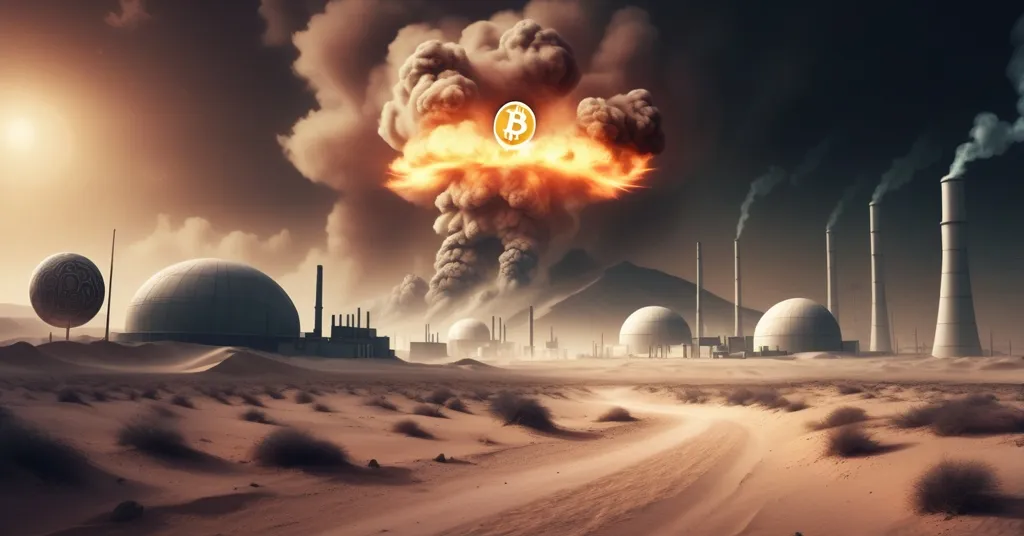Iran’s Missing Uranium Crisis: Geopolitical Fallout Hits Bitcoin and Crypto Markets

Iran’s Missing Uranium: A Geopolitical Crisis with Ripple Effects on Bitcoin and Crypto
Over 400 kilograms of uranium enriched to 60%—perilously close to weapons-grade—has vanished from the radar in Iran following devastating US and Israeli airstrikes on key nuclear facilities. This isn’t just a Middle East showdown; it’s a global crisis with tendrils reaching into energy markets, inflation, and even the volatile world of Bitcoin and cryptocurrency. As tensions soar, the question looms: can decentralized tech offer solutions where centralized powers falter?
- Missing Uranium: Over 400 kg of near-weapons-grade uranium unaccounted for after strikes.
- Targeted Sites: Fordow, Natanz, and Isfahan hit by bunker-busting bombs.
- Market Impact: Oil spikes and crypto dips highlight geopolitical shockwaves.
Airstrikes on Iran: Devastation at Nuclear Heartlands
On June 13, 2025, the US and Israel unleashed a barrage of bunker-busting bombs on three of Iran’s most critical nuclear facilities: Fordow, Natanz, and Isfahan. These sites aren’t just dots on a map; they’re the backbone of Iran’s controversial nuclear program. Fordow, an underground fortress buried deep to evade attacks, is a primary hub for enriching uranium to high levels. Natanz, with its mix of above-ground and subterranean structures, has long been a target due to its role in centrifuge operations—machines that separate uranium isotopes to boost enrichment levels for fuel or, potentially, weapons. Isfahan serves as a research and production center, housing key infrastructure for Iran’s nuclear ambitions. The International Atomic Energy Agency (IAEA), the UN-affiliated watchdog monitoring nuclear activities, confirmed significant damage at Natanz and Isfahan, with buildings razed and centrifuges likely destroyed. Fordow’s status remains a mystery due to its hidden design, though President Donald Trump boldly claimed all sites were “obliterated.”
These strikes weren’t surgical pinpricks; they were designed to cripple. Bunker-busting bombs can penetrate fortified structures, and the aftermath at Natanz shows above-ground facilities flattened and underground halls compromised. Isfahan reported four structures damaged, while internal contamination from uranium isotopes and toxic chemicals like hydrogen fluoride poses risks to workers on-site, though no public radiological release has been detected. The murkiness around Fordow, however, keeps everyone guessing—was it truly hit hard, or is Trump’s bravado just geopolitical theater? The IAEA noted as late as June 20 that no confirmed damage was reported there, adding another layer of doubt to this high-stakes puzzle, as detailed in a recent report on the strikes.
Missing Uranium: A Global Security Nightmare
Here’s where it gets dicey: Iran’s stockpile of nearly 9 tonnes of uranium includes over 400 kg enriched to 60%, a level far beyond the 3-5% used for civilian nuclear power and dangerously close to the 90% needed for a bomb. Think of 60% enrichment as refining raw sugar into a concentrated syrup—potent, and just a step away from weaponization. The IAEA can’t confirm if this material was destroyed in the strikes, buried under rubble, or moved elsewhere. Verification could take months due to restricted access, damaged sites, and Iran’s refusal to fully cooperate after a June 2025 resolution by the IAEA Board of Governors accused Tehran of violating the Non-Proliferation Treaty (NPT), a global pact to curb nuclear weapon spread.
Suspicions of relocation are mounting. Hours before the Israeli strikes on June 13, Iran notified the IAEA of “measures to protect its nuclear equipment and materials,” as stated by agency head Rafael Grossi. Satellite imagery spotted trucks near Fordow days prior, hinting at a preemptive shuffle, as documented in analysis of pre-strike movements. Moving 400 kg of uranium isn’t like packing for a road trip—it’s heavy, hazardous, and a logistical nightmare. Yet, the US isn’t buying it. Trump dismissed the idea, saying:
“They didn’t move anything. It’s very dangerous to do. It is very heavy — very, very heavy. It’s a very hard thing to do.”
Defense Secretary Pete Hegseth backed this up, stating no intelligence supports relocation. Former IAEA inspector Olli Heinonen, however, painted a grimmer picture of the verification challenge:
“There could be materials which are inaccessible, distributed under the rubble or lost during the bombing.”
Heinonen stressed that transparency is crucial for nations to assess risks, but with Iran playing hide-and-seek, we’re left with a glaring black hole of doubt. This isn’t the first time Iran’s dodged scrutiny—past inspections uncovered undeclared sites and hidden centrifuges, echoing the IAEA’s fruitless chase for WMDs in Iraq two decades ago. The stakes couldn’t be higher: if this uranium was moved, where is it now? If it’s rubble, is it secure? The answers could dictate whether this crisis stays contained or blows up—literally, as discussed in Grossi’s statement to the UNSC.
Economic Fallout: From Oil Spikes to Crypto Dips
The ripples of this nuclear ambiguity aren’t confined to security briefings; they’re slamming global markets with the subtlety of a sledgehammer. Iran, a heavyweight oil producer, sits in the volatile Middle East, and any whiff of escalation sends energy prices into a tailspin. Brent crude has surged 18% since June 10, hitting $79.04, with analysts like Saul Kavonic of MST Marquee warning that prices could rocket to $100 if Iran retaliates by targeting Gulf oil infrastructure or blocking the Strait of Hormuz—a narrow chokepoint akin to a highway bottleneck where a third of the world’s oil passes through. Supply chain fears and resource hoarding by governments are fanning inflationary flames, squeezing economies already on edge, as explored in this expert analysis on oil market impacts.
Crypto markets aren’t immune either. Ether plummeted 8.5% post-strikes as investors fled to safer assets, while Bitcoin took a 5% hit, reminding us that digital currencies don’t float in some untouchable vacuum. Geopolitical shocks bite hard, even in decentralized realms, with further insights available on how such crises affect digital assets. Yet, there’s a flip side—some Gulf stock markets have held steady or even ticked up, suggesting not all investors are panicking. Jamie Cox of Harris Financial Group offered a sliver of optimism, noting that Iran’s loss of nuclear leverage might nudge it toward a peace deal, potentially calming markets after the initial frenzy. For crypto enthusiasts, this volatility is a gut check: is Bitcoin the safe-haven asset we hype it to be, or just another risk play when the world goes haywire? History offers mixed signals—Bitcoin surged during US-Iran tensions in 2020 after Soleimani’s assassination, but today’s broader economic strain paints a different picture.
Decentralization’s Role: Can Blockchain Offer Solutions?
For us at Let’s Talk, Bitcoin, this crisis isn’t just a geopolitical thriller—it’s a screaming reminder of why decentralization matters. Bitcoin and blockchain tech could be game-changers in cutting through the fog of state secrecy. Imagine a global ledger, perhaps on Ethereum’s smart contracts or a Bitcoin sidechain, where every gram of uranium is tracked immutably. IAEA inspectors could verify stockpiles in real-time, bypassing the cat-and-mouse games of centralized reporting. This isn’t sci-fi; it’s a trustless system for a world drowning in distrust, with concepts explored in blockchain applications for nuclear security. Even beyond nuclear transparency, crypto’s role in hedging against inflation tied to oil spikes—think Bitcoin as digital gold—offers a lifeline for those burned by fiat volatility.
Let’s not get too starry-eyed, though. Skeptics argue nuclear states won’t touch decentralized tech—centralized power doesn’t play nice with trustless systems. Plus, while we champion Bitcoin maximalism, altcoins like Monero, with its privacy focus, could help regions like Iran skirt sanctions-driven financial chokeholds, though that sparks ethical debates about enabling rogue actors. Iran itself has dabbled in crypto, from state-backed digital currencies to flipping on Bitcoin mining after a 2021 ban, showing how blockchain fills niches Bitcoin alone can’t. The reality? Decentralized tech isn’t a silver bullet, but it’s a damn good tool in a crisis where opacity reigns supreme, a topic further debated in discussions on Iran’s potential use of Bitcoin.
Risks for Crypto Investors: Navigating the Fallout
Let’s be real, crypto fam—prolonged instability in the Middle East could keep markets jittery for months. Sustained oil disruptions might jack up energy costs, hitting mining operations for Bitcoin and altcoins alike. Regulatory crackdowns loom if crypto gets tied to illicit funding in conflict zones, a specter that’s haunted privacy coins for years. And while Bitcoin often shines in chaos, prolonged economic pressure could see investors dump risk assets—yes, even digital ones—for traditional safe havens like gold or bonds. On the flip side, this could be Bitcoin’s moment to prove its mettle as a store of value, especially if fiat currencies buckle under inflation. The data’s murky, and no scammy price predictions here—just a heads-up to brace for turbulence. For you OGs, it’s another day in the wild west of crypto; for newbies, it’s a crash course in how global chaos messes with your wallet, with community perspectives shared on platforms like Reddit regarding the aftermath.
Key Takeaways and Questions for Crypto Enthusiasts
- What happened to Iran’s 400 kg of enriched uranium after the airstrikes?
Its fate remains unknown—potentially destroyed, buried in rubble, or relocated. The IAEA can’t confirm due to limited access and Iran’s stonewalling. - Did Iran move its uranium stockpile before the attacks?
Evidence like a pre-strike IAEA notification and satellite imagery of trucks near Fordow suggests it’s possible, though US officials like Trump call it logistically improbable. - How does Iran’s nuclear crisis affect Bitcoin and crypto markets?
It fuels volatility, with Ether down 8.5% and Bitcoin dipping 5% as investors flee risk, showing how geopolitical shocks ripple into decentralized spaces. - What are the broader economic consequences tied to this uncertainty?
Oil prices spiked 18% to $79.04, inflation fears are rising, and supply chains are strained, though some markets hint at stabilization if tensions de-escalate. - Can blockchain tech help with nuclear transparency in crises like this?
Potentially, by offering immutable ledgers to track materials like uranium, providing a trustless alternative to opaque state reports, though adoption by nuclear powers remains doubtful.
This mess is a clusterfuck of biblical proportions, blending nuclear brinkmanship with economic collateral damage that hits everything from oil barrels to Bitcoin wallets. We’re die-hard fans of Bitcoin’s disruptive power, but let’s not kid ourselves—altcoins and broader blockchain innovations might fill critical gaps in transparency and crisis response that Bitcoin isn’t built for. Whether it’s Ethereum’s smart contracts tracking uranium or privacy coins navigating sanctions, the decentralized toolkit is vast. One thing’s crystal clear: the intersection of nukes and markets is a brutal wake-up call. We’re here to slice through the noise—no hype, no bullshit—just the raw truth of a world on edge, where decentralized tech might be our best shot at keeping things sane. Stick with us as we track how global chaos reshapes the future of freedom and finance.



